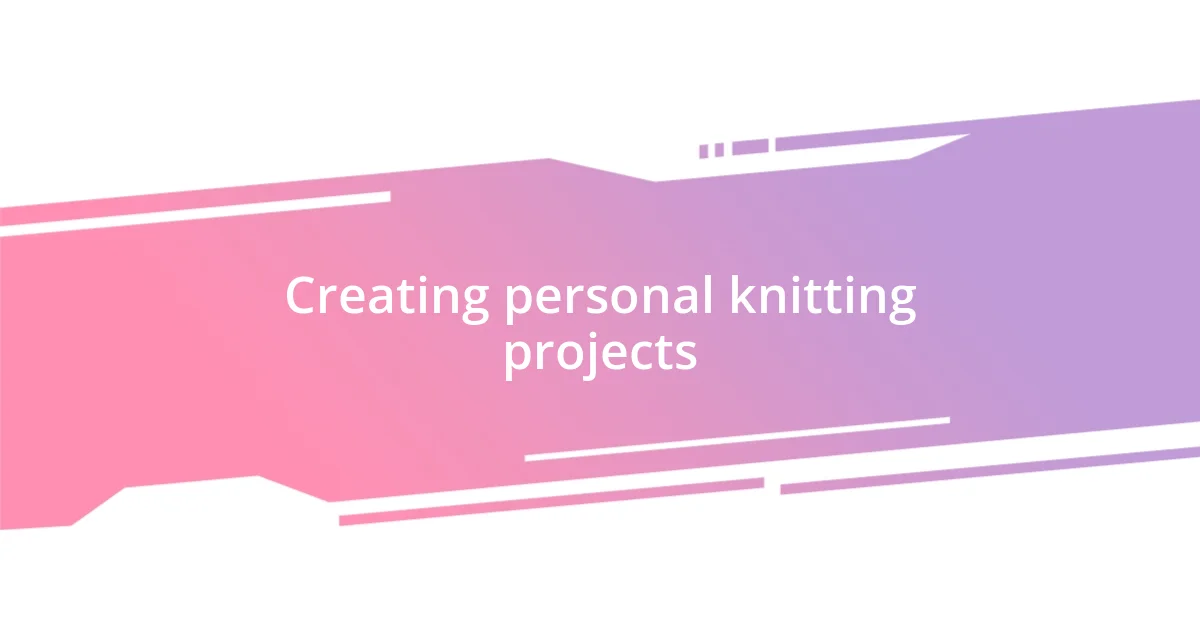Key takeaways:
- Mastering basic knitting techniques, such as knit and purl stitches, fosters creativity and a sense of achievement in transforming yarn into beautiful pieces.
- Gathering essential knitting supplies, including medium-weight yarn and comfortable needles, lays the foundation for successful projects and enhances the knitting experience.
- Creating personal knitting projects allows for self-expression and emotional connection, making each piece meaningful as it embodies individual stories and memories.

Understanding basic knitting techniques
Understanding the basic knitting techniques is like learning a new language. When I first picked up my needles, I was amazed at how the simple act of casting on a few stitches could open up a world of creativity. Can you imagine the thrill of transforming just yarn into something beautiful?
As I practiced the knit and purl stitches, I often found myself lost in the rhythm of my hands, almost meditative. I remember that moment when I finally completed my first scarf; the sense of achievement was overwhelming. It’s in these moments that I truly grasped that each stitch tells a story, weaving together my emotions and experiences.
Experimenting with techniques like ribbing and garter stitch felt like unlocking different levels of a game. The initial mistakes, like dropping a stitch or twisting my work, were frustrating but essential learning moments. Have you ever found joy in making something imperfect? Those experiences taught me resilience and patience—two invaluable traits that extend far beyond knitting.

Gathering essential knitting supplies
Gathering the right knitting supplies is like laying the foundation for a beautiful home. I still recall my first visit to the local craft store, feeling both excited and overwhelmed by the vibrant array of yarns and tools. Standing there, I realized that choosing the right materials could make all the difference in my knitting journey.
Here’s a concise list of essential knitting supplies I gathered:
- Yarn: Start with a medium-weight yarn (like worsted) for ease.
- Knitting needles: Choose a pair that feels comfortable in your hands; I favored bamboo to avoid slips.
- Scissors: Crucial for snipping yarn ends with precision.
- Tape measure: For checking the size of your projects as you go.
- Stitch markers: I found these helpful to keep track of my rows and stitches.
- Tapestry needle: Perfect for weaving in those pesky loose yarn ends.
These simple tools became my companions. Each stitch I crafted was a small step toward mastery, and I felt a flutter of excitement with every new project I took on.

Learning basic knitting stitches
Learning basic knitting stitches opened up a whole new world for me. When I first began practicing the knit and purl stitches, it felt like cracking a code. I remember gripping my needles tightly, focused on each movement. Once I got the hang of it, those same stitches became my trusted tools for creating beautiful patterns. It was amazing how something so simple could be the foundation for elaborate designs!
As I progressed, I dove into variations like ribbing and stockinette stitches. I recall one evening when I decided to try ribbing for the first time; it was a little tricky! Initially, I found myself frogging (a term we knitters use for unraveling) my work several times because I kept losing track of the stitch pattern. But once I finally mastered it, I felt a rush of pride. There’s something truly special about conquering a challenge, wouldn’t you agree?
In my experience, practicing different stitches not only improved my skills but also sparked my creativity. Each new stitch I learned felt like adding a tool to my knitting toolbox. I quickly became fascinated with how slight variations could alter the texture and appearance of a piece. Do you remember when you first discovered how one simple change could make all the difference? That’s how I felt with each new stitch I tackled.
| Knitting Stitch | Description |
|---|---|
| Knit | A basic stitch; creates a smooth texture on the front of the fabric. |
| Purl | The reverse of the knit stitch; creates a bumpy texture on the front. |
| Ribbing | A combination of knit and purl stitches; creates a stretchy fabric. |
| Stockinette | Alternating rows of knit and purl stitches; smooth on one side and bumpy on the other. |

Practicing simple knitting patterns
Practicing simple knitting patterns is where the magic really starts to unfold. I distinctly recall my first attempt at a basic garter stitch scarf—just rows of knit stitches over and over. The rhythm was soothing, almost meditative, and it felt like I was crafting something truly special with each row. Have you ever felt that thrill of seeing your work grow, even if it’s just a few inches at a time?
Once I gained confidence, I ventured into easy patterns like dishcloths and simple baby blankets. I remember one evening spent in my favorite spot by the window, sipping tea while I stitched away. The simple pattern I followed allowed me to focus on the repetitive motion, almost like a form of mindfulness. It was during those moments that I realized how knitting could calm my mind and bring joy to my heart. Why do we often overlook the peacefulness that comes from focusing on our hands?
Another pivotal point in my journey involved experimenting with patterns that combined the knit and purl stitches. I’ll never forget the satisfaction I felt when I successfully completed a simple ribbed scarf. The texture it created was unlike anything I’d made before, and that small victory fueled my desire to tackle more complex projects. Learning to engage with basic patterns not only enhanced my skills but also deepened my appreciation for the art of knitting. Have you experienced that spark of excitement when you see your potential unfold?

Expanding skills with advanced techniques
As I delved deeper into knitting, I realized that brushing up on advanced techniques really took my skills to the next level. Techniques such as cabling and lace knitting felt like stepping into a whole new dimension. I vividly remember the first time I attempted a cable pattern; I was both excited and a little terrified. The intricate twists and turns were mesmerizing. I could hardly believe my needles were capable of creating such complexity!
One night, I decided to challenge myself with lace knitting. The delicate yarn I chose seemed almost like it was dancing through my fingers. I still chuckle at the blunders I made—dropped stitches and unintended holes abound! But with each mistake, I learned something valuable. Isn’t it fascinating how every error can turn into an opportunity for growth? My persistent effort paid off; nothing could match the exhilaration of finally achieving a beautiful lace shawl.
Incorporating advanced techniques not only enriched my skills but transformed my entire knitting journey. I started to see projects as not just finished pieces, but as explorations of creativity and technique. It took a little courage to embrace this complexity, but I found that the more I ventured into uncharted territory, the more freedom I felt as a knitter. Have you ever felt that adrenaline rush when trying something new? The thrill of mastering new techniques made me appreciate the art of knitting all the more.

Creating personal knitting projects
Creating personal knitting projects has always been an outlet for my creativity. I remember the excitement of designing my first original pattern for a cozy blanket. I sketched out my ideas and played around with colors, letting my imagination run wild. Why is it that the pieces we create from our own ideas feel so much more meaningful?
When I finally set my needles to work, the process felt like pure magic. I still recall the evening I wrapped the finished blanket around myself; it felt like a warm hug crafted entirely by my own hands. Each stitch told a story and reflected my personality, making it a truly personal piece. Have you ever experienced that joy of wrapping yourself in something that embodies your effort and vision?
Once I got comfortable with the idea of personal projects, I began to explore themes that resonated with my life. For instance, I created a series of small ornaments for the holidays, each representing a cherished memory. Each ornament was a mini chapter of my life, and as I hung them on the tree, I felt a wave of nostalgia wash over me. How incredible is it to bring your life’s moments into a tangible form? It’s these experiences that remind me why I fell in love with knitting in the first place—it’s not merely about the finished product but the heartfelt connection woven into every thread.














